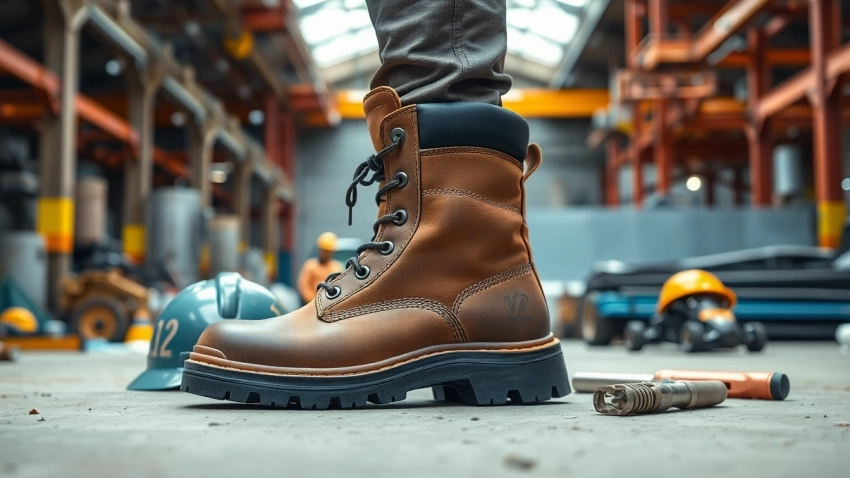
Top Features and Benefits of Safety Boots for Every Worker
Understanding Safety Boots and Their Importance
In today’s rapidly evolving work environment, the importance of proper protective gear cannot be overstated. Among various protective equipment, safety boots stand out as essential for anyone working in hazardous conditions. These boots are designed to protect the wearer from a multitude of risks, including heavy objects, electrical hazards, and slippery surfaces. Investing in quality safety boots not only assures individual safety but also enhances overall workplace productivity.
What Are Safety Boots?
Safety boots are specialized footwear designed to provide protection to the feet in environments prone to various hazards. Features often include reinforced toes, slip-resistant soles, and waterproof materials tailored to meet specific occupational requirements. Common users of safety boots include construction workers, factory employees, and outdoor professionals who face various hazards on a daily basis. The defining features of these boots vary based on industry needs but their core purpose remains the same: to safeguard against foot injuries.
Key Standards for Safety Boots
Safety boots are governed by a set of safety standards and certifications aimed at ensuring that they provide adequate protection. The most commonly referenced standard in the United States is ASTM F2413, which categorizes footwear based on protective features. This includes impact resistance, compression resistance, and electrical hazard protection. Additionally, other organizations worldwide provide their own safety criteria, driving manufacturers to produce boots that not only comply with but exceed these norms. Understanding these standards is essential for employers and employees alike when selecting appropriate footwear.
Types of Safety Boots Available
When discussing safety boots, it is important to recognize the variety available, each tailored for different job requirements and environments. Major types include:
- Steel Toe Boots: Known for their robust protection, these boots feature steel caps that shield toes from impact and compression.
- Composite Toe Boots: Lighter than steel toe boots, these use materials like Kevlar or carbon fiber to offer protection without the weight.
- Electrical Hazard Boots: Designed to protect against electrical shocks, these boots are insulated to prevent electrical currents from passing through.
- Puncture-Resistant Boots: Equipped with a plate in the sole, these boots protect against sharp objects penetrating from below.
- Slip-Resistant Boots: Ideal for wet or oily surfaces, these boots have soles designed to enhance traction.
Essential Features to Look for in Safety Boots
When selecting the right safety boots, it is crucial to consider features that will provide maximum protection and comfort throughout a workday. Here are some essential aspects to focus on:
Protection Mechanisms and Durability
The primary role of safety boots is to protect feet from injuries. Shoes must exhibit durable materials, capable of withstanding rough use over time. Features like steel toes or composite toes, metatarsal guards, and puncture-resistant soles add layers of protection against various hazards. Furthermore, the overall construction should be resilient, with material that can endure the wear and tear associated with demanding environments.
Comfort and Fit Considerations
A poor fit can lead to discomfort and, ultimately, reduced productivity. Safety boots need to fit snugly yet comfortably, providing adequate cushioning and arch support. Additionally, consider features like moisture-wicking lining to keep feet dry and breathable designs that allow for airflow. Many brands offer options that accommodate different foot shapes, ensuring that wearers can find a pair that suits their specific needs.
Material Choices and Their Benefits
The materials used in safety boots significantly affect their performance and comfort. Common materials include:
- Leather: Often favored for its durability and waterproof properties. It provides excellent protection but may require some time to break in.
- Synthetic Materials: Lightweight and breathable, these materials often offer good water resistance and are easier to break in.
- Rubber: Primarily used for slip-resistant soles, rubber provides exceptional grip on slippery surfaces.
Choosing the right material depends on the specific working environment and personal preferences.
Choosing the Right Safety Boots for Your Job
To ensure maximum protection, it is vital to select safety boots that are appropriate for your specific work environment and job requirements. Follow these guidelines to make an informed decision:
Assessing Your Work Environment Risks
Start by evaluating the risks present in your workplace. Ask yourself the following questions:
- Is there a risk of falling objects?
- Are there sharp materials, such as glass or metal, on the ground?
- Will I be exposed to electrical hazards?
- Is the surface I will be walking on slippery, wet, or unstable?
The answers to these questions will guide you in selecting the necessary protective features.
Evaluating Specific Job Requirements
Beyond general workplace risks, consider specific job requirements or industry standards. For instance, some jobs may require a particular level of water resistance or the ability to protect against chemicals. Always consult with relevant safety regulations, as some industries have strict guidelines in place regarding personal protective equipment.
Budgeting for Safety Boots Without Compromising Quality
While it is crucial to remain within budget, it is equally important not to compromise on quality. Invest in safety boots that provide the right protection and comfort for your needs. Look for brands with strong reputations and positive customer reviews, as well as those that offer warranties. Often, spending a little more on quality footwear can save money in the long run by reducing workplace injuries and boosting productivity.
Maintenance Tips for Longevity of Safety Boots
To maximize your investment in safety boots, proper maintenance is essential. Following these tips can extend the life of your footwear:
Cleaning and Care Instructions
Regular cleaning can prevent dirt and grime buildup, which can damage the material. Use a soft brush or cloth to remove surface dirt and mild soap for tougher stains. If boots are leather, consider using a conditioner to keep them supple.
Signs Your Safety Boots Need Replacement
Monitor your boots for signs of wear and tear, which may indicate a need for replacement. Key indicators include:
- Visible damage to the outer material or seams.
- Worn-out soles that affect traction.
- Loss of cushioning and support.
- Foul odors that indicate bacteria or mold.
It’s important to replace boots that show these signs to maintain safety standards.
Storage and Protection Strategies
When not in use, store safety boots in a cool, dry place away from direct sunlight. Keeping them organized in boxes can prevent accidental damage and maintain their shape. Additionally, avoid placing heavy objects on top of the boots, which can deform them over time.
Frequently Asked Questions About Safety Boots
As you consider investing in safety boots, you might have questions regarding their usage, fit, and misconceptions. Here are some common queries to clarify:
How to Properly Fit Safety Boots?
To achieve the best fit, try on safety boots at the end of the day when your feet are slightly swollen. Walk around in them to check for comfort and support. Ensure that there’s enough room for toe movement without excessive slippage at the heel.
Can Safety Boots Be Worn in Non-Industrial Environments?
While designed primarily for industrial use, many safety boots feature stylish designs suitable for casual wear while still providing protection and comfort. Consider choosing safety boots that meet workplace dress codes while providing the necessary safety features.
What Are the Most Common Misconceptions About Safety Boots?
Several misconceptions surround safety boots that can lead to poor purchasing decisions. One common myth is that safety boots are always heavy and uncomfortable; however, advancements in technology have led to the production of lightweight and highly comfortable options. Another misconception is that any sturdy boot can be classed as a safety boot, which is incorrect. Only those that meet specific protective standards should be relied upon.












Leave a Reply